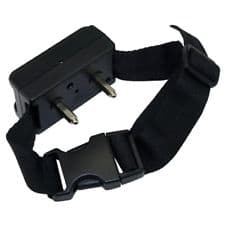Shock collars — the cruel and lazy way

So, you have a dog, adult or puppy, that is proving challenging to train. It may run off and have poor recall or, it may not respond to commands as you would wish. You are at your wits end, perhaps not have the knowledge or experience to deal with the situation. The next step is, usually, to find professional assistance. At this point stop and think carefully before choosing a dog trainer. Be prepared to seek clarity about there approach. Many trainers recommend the use of shock collars.

These shock collars are in common use throughout the UK (in fact, there is a staggering number sold to dog owners — with little, or no useful guidance on how to use them); these devices should never, be used in my opinion. Anything that inflicts pain to elicit a desired behaviour should be avoided. Unscrupulous and ill informed trainers push these awful devices for anything ranging from stopping barking, keeping the dog with home boundaries or anything else they can think off.
How does the shock collar work? The clue is in the title. an electric shock is delivered (the intensity is variable — from very low to quite extreme and painful levels). Trainers will, often, demonstrate on a client with the lowest setting ( a little discomfort) but, then make sure the setting is much higher for the dog to ensure the desired response.
In anyone’s hands, let alone the untrained, these collars can cause significant pain and resultant behavioural problems for your dog.
Because of the use of such devices, a dog can quickly start to display learned helplessness. Lindsay (2000, p.253) states that under conditions where aversive stimulation (in this case, the shock from the collar) is used on a non-contingent basis, this can result in a number of devastating interference effects called ‘learned helplessness’. This impedes the dog’s normal escape and avoidance learning (owner’s often describe this a the dog ‘shutting down’). Learned helplessness was first described in 1967 with Seligman’s experiment of dogs (Seligman and Maier, 1967). Put in simpler terms, the dog experiences pain that it cannot get away front — they, eventually, just give up and stop responding to the pain inflicted.
- An example of learned helplessness is the dog owner who uses a shock collar to prevent the dog from running away. The dog is shocked when the owner thinks it is getting too far away, the shocks continue, even when the dog is returning to the owner. Clearly, the dog is unable to get away from the pain of the shock — eventually, it does not know how to respond, so it either, just stops or keeps running.
- To retrain a dog who is suffering in this way, I would recommend:
- stop using the shock collar, immediately
- introduce the dog to a ‘normal’ collar — this should be done slowly and gently (the dog will have associated the collar with negative experiences) — this should be accompanied by positive reinforcement using treats and a calm, gentle approach and praise (primary and secondary reinforcers)
- when the dog has associated the new collar with a positive experience, the next step:
- teach sit / stay — this should be done using positive reinforcement:
- on successful sits — use a primary reinforcer, a treat and a
- secondary reinforcer, ‘well done’ verbal praise
- use the same for the stay
- when the sit / stay is reliable and reproducible, proceed to
- recall training (this may take time — the dog has strong, negative associations with this)
- using a long lead ◦ put the dog into sit and retreat a few feet. Call the dog (an alternative to ‘come’ may be appropriate, if the dog is already used to ‘come’ with a shock) using ‘here’ — positive and with some excitement
- when the dog comes, reward with a special treat, praise the dog ‘well done!’
- repeat until the dog is able to sit/stay at the full length of the lead (maybe, 30–50 feet, or so)
- now repeat the above with the dog off the lead, starting short and then increasing the distance
- I would also use visual signals and for longer distances a whistle
This training should be fun for the dog, yanking on the lead to get compliance will not help with this dog. All of the above steps should have been done in a secure location (a large garden, for instance).
Finally, take the dog to a more open area, perhaps a park and repeat the steps above. This process, will probably be a long one.
This method of training and behavioural modification relies on kindness and positive reinforcement for the dog. ANYONE that eschews the use of kindness based techniques and promote the use of shock or prong collars should, be avoided at all costs.
References
Lindsay, S. (2005). Handbook of applied dog behaviour and training. Ames, Iowa: Iowa State University Press.
Seligman, M. and Maier, S. (1967). Failure to Escape Traumatic Shock. Journal of Experimental Psychology, 74(1), pp.1–9.
